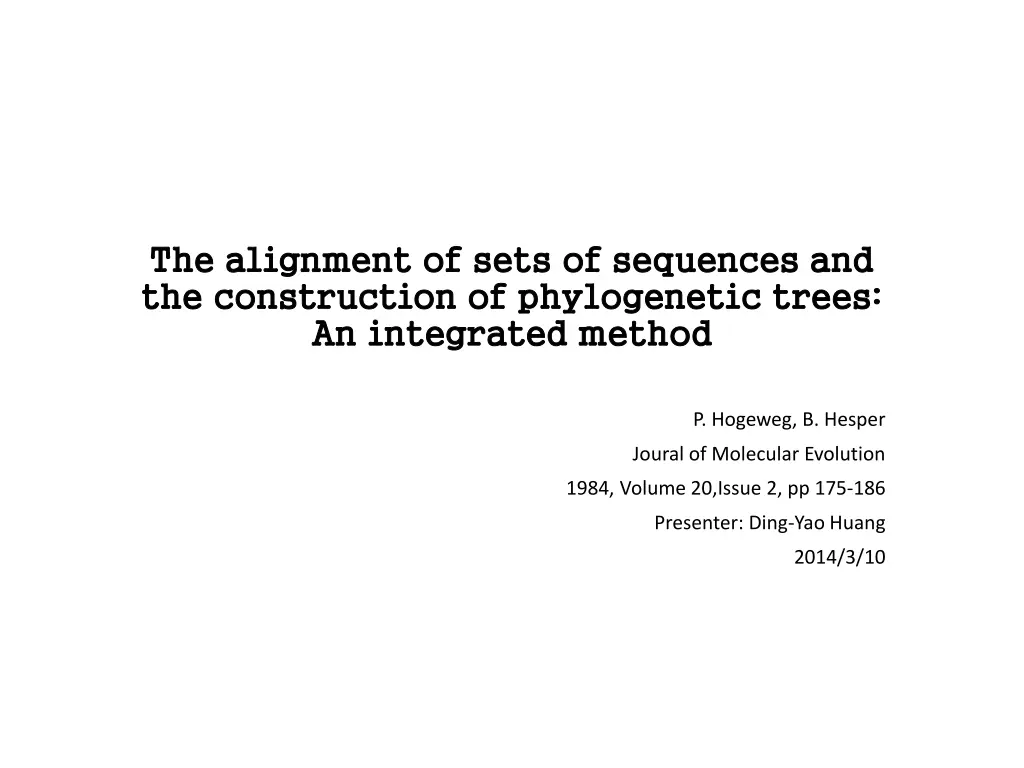
Integrated Method for Sequence Alignment and Phylogenetic Tree Construction
Explore the integrated approach for aligning sets of sequences and constructing phylogenetic trees. This method utilizes iterative processes to align sequences and adjust trees simultaneously, demonstrating its application in analyzing 5S rRNA sequences in prokaryotes efficiently.
Download Presentation

Please find below an Image/Link to download the presentation.
The content on the website is provided AS IS for your information and personal use only. It may not be sold, licensed, or shared on other websites without obtaining consent from the author. If you encounter any issues during the download, it is possible that the publisher has removed the file from their server.
You are allowed to download the files provided on this website for personal or commercial use, subject to the condition that they are used lawfully. All files are the property of their respective owners.
The content on the website is provided AS IS for your information and personal use only. It may not be sold, licensed, or shared on other websites without obtaining consent from the author.
E N D
Presentation Transcript
The alignment of sets of sequences and The alignment of sets of sequences and the construction of phylogenetic trees: the construction of phylogenetic trees: An integrated An integrated method method P. Hogeweg, B. Hesper Joural of Molecular Evolution 1984, Volume 20,Issue 2, pp 175-186 Presenter: Ding-Yao Huang 2014/3/10
Abstract Abstract In this paper we argue that the alignment of sets of sequences and the construction of phyletic trees cannot be treated separately. The concept of good alignment is meaningless without reference to a phyletic tree, and the construction of phyletic trees presupposes alignment of the sequences. We propose an integrated method that generates both an alignment of a set of sequences and a phyletic tree. In this method a putative tree is used to align the sequences and the alignment obtained is used to adjust the tree; this process is iterated. As a demonstration we apply the method to the analysis of the evolution of 5S rRNA sequences in prokaryotes.
The Alignment of Molecular The Alignment of Molecular Sequences Sequences Alignment Insertions Deletions Changes Sequence A Sequence B FAJG_SDJ_FZX F_JABS_JCFZX Bias Bias=X,Y X insertion/deletion penalty( 1) Y penalty( 0.1) FAJG_SDJ_FZX F_JABS_JCFZX 7-2*1-2*1-4*0.1-2=0.4
Phyletic Tree Construction Phyletic Tree Construction Heuristic methods Matrix method No need a global alignment A B C D A - 0.3 0.6 0.4 B 0.3 - 0.2 0.8 C 0.6 0.2 - 0.6 D 0.4 0.8 0.6 - Character-based method Need a global alignment Species A Species B FAJG_SDJ_FZX F_JABS_JCFZX
Tree Tree
Method(outline) Method(outline) 1. The concept of good alignment refers to ancestry 2. Alignment and tree construction are decided by maximal matching 3. Pairwise alignments are feasible 4. Use matrix method to construct the tree 5. This tree is a binary tree 6. Alignments of the similarity sequence are the most reliable 7. Internode sequence ATCGCGATA ATTGCGATA ATCGCGGTA
Method Method Step1: Create N*N similarity matrix Step2: Construct phyletic tree Step3: Construct pairwise alignments and internode sequence Step4: Calculate the number of mutations and draw the tree Step5: Calculate character weights by the mutational frequency Step6: Adjust the similarity matrix by character weights Step7: Repeat from Step2 until convergence or the stopping rule is satisfied
Method Method Step1: Create N*N similarity matrix A B C D A - 0.3 0.6 0.4 B 0.3 - 0.2 0.8 C 0.6 0.2 - 0.6 D 0.4 0.8 0.6 - Step2: Construct phyletic tree
Method Method Step3: Construct pairwise alignments and internode sequence ATCGCGATA ATCGCGATA |||| | | || ATCGCGGTA ATTGCGATA ATCGCGGTA Step4: Calculate the number of mutations and sign the branch length ATCGCGATA 1 1 ATTGCGATA ATCGCGGTA
Method Method Step5: Calculate character weights by the mutational frequency Wi=Ni/(Mi+1) Wi: the weight at the i-th position Ni : the number of difference amino acid at this position Mi:the number of the mutations at this position Step6: Adjust the similarity matrix by character weights A B C D A - 0.3 0.6 0.4 B 0.3 - 0.2 0.8 C 0.6 0.2 - 0.6 D 0.4 0.8 0.6 - Step7: Repeat from Step2 until convergence or the stopping rule is satisfied
Implementation of The Method Implementation of The Method ( (Group Averaging Group Averaging) ) UPGMA A 1 2 7 4 3 B C 3 2 E A B C D E 1 A - 8 6 11 12 D B - 12 17 18 C - 11 12 D - 3 E -
Implementation of The Method Implementation of The Method (Group Averaging) (Group Averaging) A B C D A-C B D A-C - 10 11 A - 8 6 11 B - 17 B - 12 17 D - C - 11 D - A C B D
5S 5S- -rRNA(group averaging) rRNA(group averaging)
5S 5S- -rRNA(group averaging) rRNA(group averaging)
5S 5S- -rRNA rRNA(Present (Present- -Day Day Ancestor Method Ancestor Method) )
5S 5S- -rRNA rRNA( (Present Present- -Day Ancestor Method) Day Ancestor Method)
Conclusions Conclusions Propose an integrated method Alignment Phyletic tree Use non-optimal methods optimally Flexibility Explicitness
